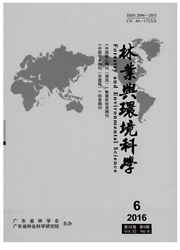

 中文摘要:
中文摘要:
以广州市黄埔区南亚热带常绿阔叶木荷(Schima superba)风水林群落为对象,用样地生物量法对乔木、灌草、凋落物、细根和土壤层的碳库储量进行计量,并用碳税率法参数估算了群落碳库价值。结果表明:(1)3个样地的生态系统碳储量密度在138.00~176.56 t C·hm^-2之间,平均为155.34±11.30t C·hm^-2,但与地带性顶级群落碳储量密度相比,该风水林还具有较大的增汇空间;(2)乔木层、灌木层、草本层、凋落物层、细根层和土壤层的碳储量密度占生态系统总碳储量密度的比例分别为70.17%、2.74%、1.43%、0.88%、0.81%和23.97%,乔木层是生态系统碳库的主要贡献者;(3)广州市典型木荷风水林总碳资产价值平均为18.64万元·hm^-2,其中植被层为14.17万元·hm^-2,土壤层为4.47万元·hm^-2,前者是后者的3.17倍,植被层碳是风水林碳汇价值的主体部分。
 英文摘要:
英文摘要:
In this study, taking the Schima superba Feng-Shui woods community, which was the south subtropical evergreen broad-leaved forest in Huangpu district of Guangzhou city, as the experiment objects, the carbon storage of arbor, brushwood, litter, fine-root, and soil layers of S. superba forests were measured by the biomass sample method, and the value of community carbon storage was estimated by using the carbon tax rate method parameter. The results showed that:(1) The density of carbon storage in ecosystems of three sample plots were between 138.00 to 176.56 t C · hm^-2, with an average of 155.34 ± 11.30 t C · hm^-2, however, compared with the density of carbon storage in zonality climax community, this Feng-Shui wood has a large room for the carbon sink increase;(2) The proportions of carbon storage in the arbor layer, shrub layer, herb layer, litter layer, fine-root layer, and soil layer to the total carbon storage of the ecosystem were 70.17%, 2.74%, 1.43%, 0.88 %, 0.81% and 23.97%, respectively, and the arbor layer is the main contributor to the ecosystem carbon pool;(3) The average carbon asset value of typical Feng-Shui wood in Guangzhou was 1.86×10^5 RMB per hectare, of which the vegetation layer is 1.417×10^5 RMB per hectare, the soil layer is 4.47×10^4 RMB per hectare, and vegetation layer is the main part of the carbon sink value in Feng-Shui wood.
 同期刊论文项目
同期刊论文项目
 同项目期刊论文
同项目期刊论文
 期刊信息
期刊信息
